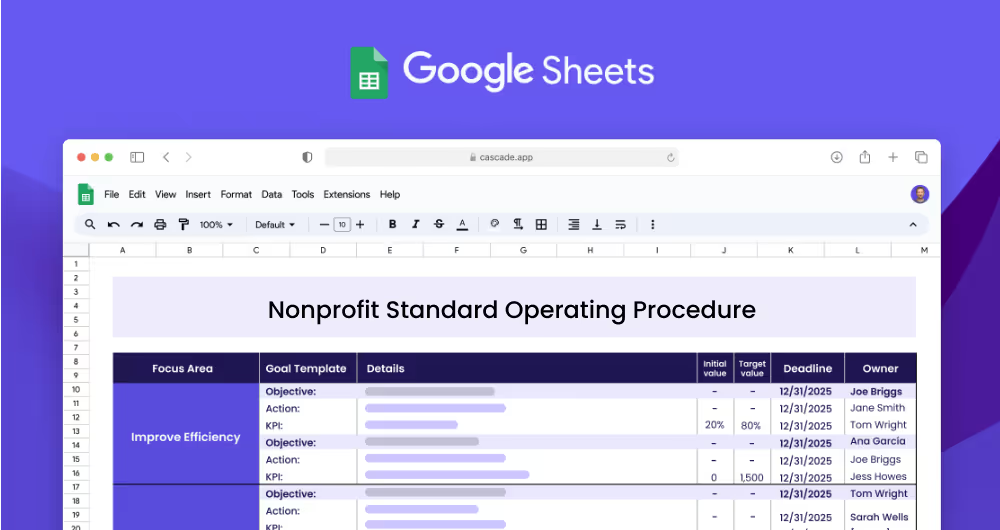Nonprofit Standard Operating Procedure (SOP) plans provide guidance and direction for the staff and volunteers of a nonprofit organization. The SOP plan outlines procedures related to a variety of operational activities, such as fundraising, accounting, communications, and program delivery. It also describes the roles and responsibilities of each individual within the organization, and outlines the processes for fulfilling those tasks. The purpose of a SOP is to ensure consistent and efficient procedures are followed throughout the organization.
Each focus area has its own objectives, projects, and KPIs to ensure that the strategy is comprehensive and effective.
This Nonprofit Standard Operating Procedure Plan template is for any nonprofit organization that is looking to improve the consistency and efficiency of their operations. This template provides a structure for nonprofits to establish clear objectives and measurable targets (KPIs) for each of their focus areas. It also outlines the projects and actions necessary to achieve those KPIs. Finally, it provides guidance on using the Cascade Strategy Execution Platform to monitor progress and see faster results from organizational goals.
When setting up your Nonprofit Standard Operating Procedure, it’s important to define clear examples of focus areas. Focus areas are the key areas of your organization that you want to improve or develop. Examples of focus areas can include operational efficiency, fundraising activities, employee engagement, and customer service. It’s important to be specific when defining each focus area so that it’s clear what your organization is trying to accomplish.
Once you’ve identified the focus areas of your organization, it’s important to think about the objectives that could fall under each focus area. Objectives are the specific goals that you’d like to achieve. For example, under the focus area of operational efficiency, you may have an objective to reduce manual back office processing time. Having clear objectives will help you better measure the success of your organization.
In order to track progress towards your objectives, it’s important to set measurable targets or Key Performance Indicators (KPIs). KPIs are the metrics that you use to measure the success of your organization. For example, if you have an objective to reduce manual back office processing time, a KPI could be to decrease processing time from two hours to one hour. Setting measurable targets will help you better monitor your organization’s progress.
Once you’ve set measurable targets, it’s important to implement related projects (or actions) to achieve those KPIs. For example, if you have a KPI to decrease manual back office processing time from two hours to one hour, an action to achieve this could be to implement automation software. Having clear and specific projects to work on will help you better reach your KPIs.
Instead of relying solely on manual controls and static spreadsheets, empower your strategy with Cascade Strategy Execution Software. Cascade outshines traditional methods by providing a centralized platform for real-time updates, collaboration, and automated reporting. This makes it significantly easier for your team to track progress, adapt quickly, and maintain alignment across all departments. Sign-up for free or book a demo with one of our strategy experts to explore how Cascade can transform your organization's operational efficiency.


